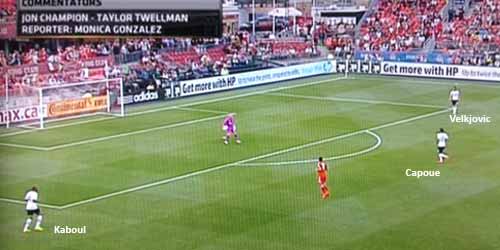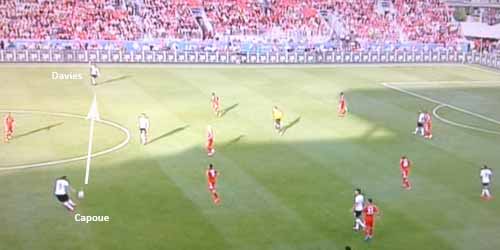Mauricio Pochettino is bringing a new style of play and philosophy to Spurs this season.
In a series of posts I’ve been looking at what this will mean for each aspect of the team. If you’ve missed any, you can read the overview of his system here. You can also catch up with the changes required from our goalkeepers and also our defence by clicking the links
Next up in our series we move on to the midfield, the largest department for change and we’ll start off at the base.
Defensive midfielder
There are two players in the pivot for Mauricio Pochettino. One of these operates as a much more defensive player, who can keep the ball moving when in possession.
This player has a number of roles:
1. Drop in between the wide splitting centre backs
2 Be a release valve for passes backwards
3. Move the ball to the more attacking players, especially the full backs
4. Screen the defence to regain possession
This player for Southampton was often Victor Wanyama. If we look at each of these points in turn, we can see what was required of him.
I’ve already talked about his movement between the centre backs in the Mauricio Pochettino system overview article. It’s also something we can see we’ve already incorporated in to our pre-season friendlies with Etienne Capoue doing this.

He does this to provide an extra man against the opposition, so the goalkeeper should have an out ball to get the attack moving.
We can also see this pass out from the keeper to the defensive midfielder if we look at Southampton’s match with Fulham last season. Here Wanyama filled the position and received four passes out from Artur Boruc.

We can also see in the diagram how Victor Wanyama is used as a release valve. This is the second part of his role.
In the overview post I talked about how the Saints move the ball vertically, but often in the middle third it has to go backwards due to opposition pressure. This is where the defensive midfielder needs to be available to receive a pass back inside, which Wanyama is readily available for.
Once he has the ball, he has then to be able move it across the formation, sometimes over distance.
If we look at Wanyama’s passes played, we can see how a lot are diagonally across the pitch, especially over distance out to the left. This quickly switches the side and focal point of the attack.

In our recent pre-season match with Toronto, Etienne Capoue was doing this to find Ben Davies.

In the defensive phase, Wanyama was tasked with screening his defence, but often he is helped out by the other midfielder in the pivot once he is back in position. This means that Wanyama will cover out to the right to help his centre back while the full back on that side has gone up-field. Morgan Schneiderlin, as you will see next, will help out on the left once he has got back in position.

Overall, the defensive midfielder not only has to be good at wining the ball back, he also needs to be adept at distributing it accurately, often over distance.
Box-to-box midfielder
The second player at the base of the midfield is a box-to-box player. This man is required to help out in the defensive phase, then get forward and support the forwards in the attack, often arriving late in the penalty area. This player for Mauricio Pochettino at Southampton was Morgan Schneiderlin.
The movement of this player is often affected by what is going on in front of him.
In the defensive phase he will press behind the attacking players, but he will drop in on the left to help cover the full back on that side when he has gone forward. Wanyama, as we saw above, would cover the right.

This is because on the left, Jay Rodriguez plays as a wide forward, moving inside so that Luke Shaw can overlap. Schneiderlin has to help to keep a balance on this side, and his left-sided focus can be seen from where he receives the ball.

He takes 16 passes from Dejan Lovren who splits wide in to the left back zone when Southampton are in possession. Schneiderlin then delivers it forward to left back Luke Shaw who has moved past Jay Rodriguez on the overlap to cross.
Once Schneiderlin has done this, his job is to get forward and arrive late in the box to create an overload. The defence will be pre-occupied with the centre forward and the inside cutting wide-forward, often leaving Schneiderlin arriving late in the box and unmarked.
Wide forward
Ahead of the two players at the base of midfield, Mauricio Pochettino has a number of options.
On the left, he usually employs a wide forward in Jay Rodriguez. This player has two main roles. Firstly to look to run in-behind off the centre forward who will have come short to drag the defence out; then secondly to arrive in the box to create a second striker when the Saints get in to a crossing position.
We got a first-hand view of his ability to run in-behind as he opened the scoring at White Hart lane in Spurs 3 Southampton 2 last season.
But his role is to also start wide and then move in-field and get in the box; something we can see from the passes he received against Fulham.

The wide forward can often be one of the most dangerous players on the park if the timing of his runs are right. This was something that Rodriguez proved by finishing as Southampton’s top scorer under Mauricio Pochettino last season.
Wide midfielder
On the opposite side to the wide forward, Mauricio Pochettino plays a wide midfielder. This is probably the manager’s most versatile tactical position on the pitch. Here Pochettino has the option to use one of three different types of player depending on what he wants.
If he wants a player that is very adept at crossing, then he will use James Ward Prowse.

If he wants to overload the opposition in the middle of the park and get 4 players in to central midfield, then he will employ a drifter who can pick a pass in Steven Davis. In this situation he uses the right back on the overlap to provide the crosses from the right side as Davis moves in-field.

Thirdly, if he wants a hybrid of the first two then he will use Adam Lallana as the wide midfielder. In this role, Lallana can drift and overload in the centre and play through passes, but he can also use his dribbling to get in to positions to play crosses.

The wide midfielder position is the one where Mauricio Pochettino has the most options and often where the name will vary the most on the team sheet.
Number Ten
Along with the wide midfield position, the second place where Mauricio Pochettino has options is in the number ten role. Here he will often use Adam Lallana, as this is where he is at his most dangerous, but he also can field a support striker in Dani Osvaldo.
The two naturally give the formation different looks depending on who is selected. Lallana has the ability to work not only between the lines, but also in the channels. This was something he did well against us, as Southampton hit him with a lot of straight vertical passes.

From there he can use his dribbling to get in to positions to play through balls and short pull backs inside the penalty area.

Adam Lallana is usually the natural choice as the number ten, but Mauricio Pochettino has also handed the role to Dani Osvaldo to play it as a support striker.
Osvaldo brings more of a physical presence to the role and so can be hit with longer balls forward. This means that Southampton can go quicker from back to front with both Lambert and Osvaldo on the field. It also means that they also have an additional player who likes to get in the penalty area, which makes a difference against teams that sit back.

Of course what you gain in firepower by having an additional man on top, you lose in creativity. Although Osvaldo could pick out a team mate, his passing was not that of Lallana.
Mauricio Pochettino and 4-3-3
Mauricio Pochettino has plenty of options to run his midfield and he also has the option to go 4-3-3.
When he opts for this formation, he will often bring either Adam Lallana or Steven Davis in to make a midfield trio with Morgan Schneiderlin and Victor Wanyama. This gives him a creative passer, a box-to-box player and a defensive midfielder.
He will then go with three forwards, which is something I will look at further tomorrow when analysing what changes we’ll see from our attacking players. Be sure to check back then or look out for the article link on Twitter or Facebook.

Perfectly put! hopefully perfectly executed?!!
Thanks Ses, i hope so as well!
Read all of your pieces so far, all very well written and insightful. Who will play in the decisive wide right for us this year? Could Lennon do it?
Good question Jon. I kind of see it being Eriksen at the minute. Lennon could do it if Poch requires a winger in that position, but otherwise i think he’ll go for a drifting playmaker like Eriksen. My only other view would be that maybe he’ll switch the wide forward role from the left to the right. Poch likes an inverted player in this position and that would suit Lamela having played this role from the right for Roma.
Can’t help reading this and thinking that we have bags of talented player who can fit the mold you’re describing. All things considered ‘the champions league is looking ever closer. Although I liked Sigurdsson, an amicable exchange of a left-back (FINALLY) and a top goal-keeper (who I assume is OK with being mostly cup-capped) really couldn’t be a better deal. Gotta hand it to Levy, when he makes a deal, he makes a deal (save perhaps Lamella and Soldado, but that could change.)
Anyway, do you think that Davies and Rose are adequate for the position which has been so problematic? I suppose you could use Vertonghen if needed to close down games or for aerial threats. It’s probably to early in the day to be making such predictions, but what is the transfer season for if not wild, partially-informed guessing and some mild-hubris??
Haha, yes it is that time of year for wild predictions! I do see Rose as being an adequate back-up for Davies. I don’t see why you’d spend money on someone to come in to play second fiddle when Davies was obviously the number one summer target. The only reason i would go for someone else if is an opportunity came up that was decent, you can bring them in relatively cheaply and also not have to spend much on wages.